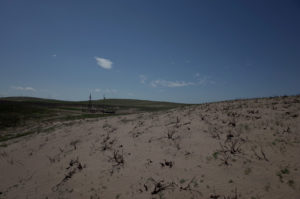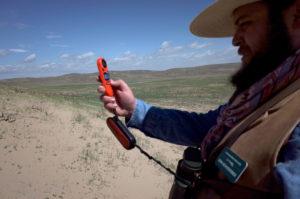Rangelands are slow to recover in Northeast Colorado
by Joanne Littlefield | May 17, 2017 12:53 PM
It’s not easily seen as you whiz by in a vehicle along Interstate 76 in Northeast Colorado. A fire ravaged the area in early March, killing cattle, decimating the rangeland, burning homes, structures, and farm equipment. But, rain in the area, as well as the proactive actions of local ranchers, have led to the slow beginning of recovery. Over 32,000 acres were impacted (larger than the size of Disney World, nearly double the size of Manhattan).
The fire began northeast of Sterling, near the Logan County town of Proctor. Within eight hours, the fire had raced 23 miles across Interstate 76 into Phillips County, toward Haxtun. Haxtun is about 150 miles northeast of Denver. CSU Extension was uniquely positioned to provide services in response to the disaster, with the Northeast Regional Engagement Center in Sterling housing a regional range management specialist, in addition to livestock agents located in Sterling and Wray.
Cropland that has been impacted by the Logan-Phillips fire has been supplemented with manure by the truckload brought in to aid with soil recovery. Affected rangelands, which are lands that are dominated by native vegetation and are uncultivated, have  received less assistance. The impact to livestock producers who utilize the grazing lands is significant because that land cannot be grazed (called “resting”) for an extended period of time.
received less assistance. The impact to livestock producers who utilize the grazing lands is significant because that land cannot be grazed (called “resting”) for an extended period of time.
“Probably the biggest long-term impact is replacing the lost animal unit months (AUMs) of grazing,” said Don Schoderbek, regional Extension range specialist. “It’s a scramble to find any pasture that they can, and either not increase herd size or find a way to decrease their herd.” Schoderbek is working with ranchers in the area on strategies to rest the range, monitor recovery efforts, and assess timing for moving animals back onto the land. “The ranchers are making decisions in their financial best interest,” said Schoderbek. ”And the best thing for the environment is the best thing for the rancher… period.”
The wind blows strong at times across these rangelands, and without plants to hold the soil in place, the soil runs in ribbons across the land. The question is how long is it going to take for the fire-scarred land to recover; annual rainfall for this region is 17-18 inches per year.
 “The biggest issue is going to be building back topsoil and that can take 25-50 years or more. In this sand country you never can tell,” said Schoderbek. “The primary driver of that is moisture, and that’s going to be what determines how long it takes to get cattle back on here, and building that topsoil back up.”
“The biggest issue is going to be building back topsoil and that can take 25-50 years or more. In this sand country you never can tell,” said Schoderbek. “The primary driver of that is moisture, and that’s going to be what determines how long it takes to get cattle back on here, and building that topsoil back up.”
CSU Extension specialist Don Schoderbek (left) measures wind speed/potential erosion on a burned sand dune in NE Colorado.
Source URL: https://source.colostate.edu/rangelands-slow-recover-northeast-colorado/
Copyright ©2024 SOURCE unless otherwise noted.